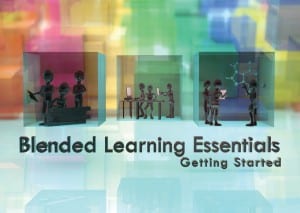Blended Learning Essentials has definitely got started!
By Eileen Kennedy, on 7 November 2015
https://www.futurelearn.com/courses/blended-learning-getting-started
Managing the ambitious Ufi-funded MOOC project that is Blended Learning Essentials has required a leap of imagination. Back in May, we had no video, no scripts, no quizzes, no Padlets, no glossary, no crib sheets, no Digital Champions, no flyers, no tweets, no conference keynotes, nothing built on the FutureLearn platform. Diana Laurillard and Neil Morris had expressed a desire for video of actual teaching with actual learners using actual blended learning techniques in actual colleges and actual private training providers. Where were we going to get that from? And to add some extra spice, by the time Suzanne Scott from Borders College had consulted teachers in the Vocational Education and Training sector to establish what we needed, it was the height of summer, and all the colleges were having a break.
Thankfully, we had a supremely talented team combining Evans Woolfe Media, who travelled the country interviewing, shooting and editing video, and University of Leeds Digital Learning Team who put it all together, and as if by magic we started to see a MOOC emerge. Meanwhile, Maren Deepwell from ALT was working tirelessly on planning a marketing campaign to beat all others, and plotting accreditation pathways for our learners to progress from the MOOC. In the background, Richard Nelson from Bradford College was assembling a force of Digital Champions to support the MOOC, and creating a plan for how they could do it.
I was working with further education teachers to make the crib sheets – including the brilliant Wendy Rogers, just retired from a glorious career at Croydon College, Phil Durrant, and my colleagues at UCL Institute of Education – Rebecca Wilson, Tim Neumann and Kit Logan, who also helped to bring them to life in our UCLeXtend Moodle course. Rachel Challen from Loughborough College was thinking about the best way to evaluate the course, and all our other partners in colleges and organisations (AELT, ETF, AOC, Tinder Foundation, NIACE, Sheffield College and Northern College) were contributing to videos and promoting the course to their members. So many people, so much enthusiasm, so much talent! Even so, it was an incredible challenge – six months to launch the first of our two MOOCs to transform the landscape of vocational education and training.
But finally it is a reality, and we have reached the end of week 1. It was a major feat from our end to be sure, but that was only ever half the story. The participants themselves are the main part of the picture. I am seriously impressed by the energy and insight of the contributions that everyone is making on and off the FutureLearn platform. I have never enjoyed a MOOC so much – the discussion is great. Obviously, it is my favourite subject, but even so – I have to stop myself spending all my time reading the comments, and following the links that people have posted. It is making me think that this project could really change things and it is great to have been a part of it.
 Close
Close





